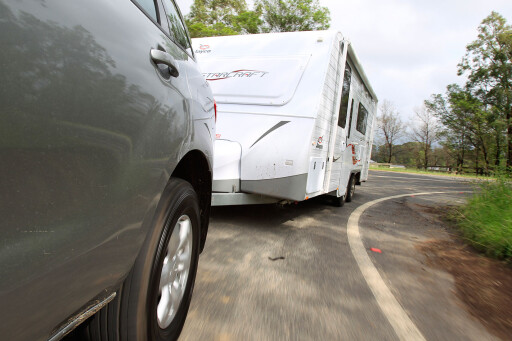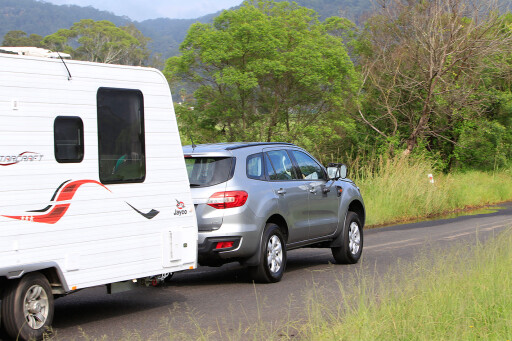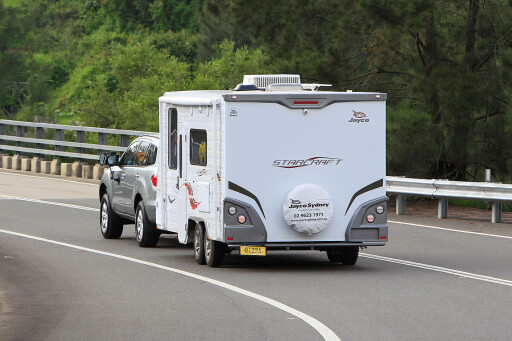.jpg )
THE Ford Everest had the most power and second-highest peak torque at the 2017 Tow Test, but it was also one of the heaviest wagons. That made its towing performance a surprise – we didn’t think it would do so well.
The Everest cruised comfortably and quietly on the freeway with the ’van behind it. The six-speed auto transmission was happy to stay in sixth gear on the plains, with the engine revving at just 1800rpm at 100km/h. However, inclines saw it downshift to fifth and sit at 2200rpm.
 The Everest was the best-performing wagon of the bunch, except for the 0-60km/h increment where it was pipped by the Holden Trailblazer. While the redline is at 4700rpm, the Everest upshifts at 3400rpm in Drive and 3700rpm in Sport mode – clearly it is not lacking in performance by not revving higher, and peak power is reached at just 3000rpm anyway. Given how noisy the inline five gets, it’s not such a bad thing anyway.
The Everest was the best-performing wagon of the bunch, except for the 0-60km/h increment where it was pipped by the Holden Trailblazer. While the redline is at 4700rpm, the Everest upshifts at 3400rpm in Drive and 3700rpm in Sport mode – clearly it is not lacking in performance by not revving higher, and peak power is reached at just 3000rpm anyway. Given how noisy the inline five gets, it’s not such a bad thing anyway.
 The hill climb wasn’t an even grade, starting as a shallow climb and gradually becoming steeper. While this allowed the Everest to easily build up speed initially, even the steep section didn’t dampen the wagon’s enthusiasm. The Everest recorded the fastest speed at the top of the hill, at 88km/h.
The hill climb wasn’t an even grade, starting as a shallow climb and gradually becoming steeper. While this allowed the Everest to easily build up speed initially, even the steep section didn’t dampen the wagon’s enthusiasm. The Everest recorded the fastest speed at the top of the hill, at 88km/h.
Ford Everest receives ARB treatment
That slightly rough, noisy five-cylinder engine comes into its own in term of engine braking – the Everest felt as though it was almost going to come to a stop on one less-steep section of the test hill.
Fuel consumption was on the higher end of the scale in this group, but at least the Everest’s 80-litre tank gives you a realistic touring range of slightly less than 500km.
 With 180kg of caravan weighing down on its towball, the Everest’s body dropped 35mm at the rear and rose just 5mm at the front. While the rear drop is a little high, it’s not excessive. The Everest’s rear axle-to-towball measurement was 1225mm, a relatively short distance that can only help towing stability together with its 2850mm wheelbase. The Ford has trailer sway control, should things get out of hand.
With 180kg of caravan weighing down on its towball, the Everest’s body dropped 35mm at the rear and rose just 5mm at the front. While the rear drop is a little high, it’s not excessive. The Everest’s rear axle-to-towball measurement was 1225mm, a relatively short distance that can only help towing stability together with its 2850mm wheelbase. The Ford has trailer sway control, should things get out of hand.
4x4 Load and Tow test comparison: 2016 Ford Ranger review
Not that that will happen easily. The Ford was quite stable with a caravan behind it and was hardly impacted by cross-winds, bow-waves created by passing trucks, or the varied road conditions we encountered. Its ride was on the firm side with the caravan coupled up behind it, but not jittery or uncomfortable.
 The Everest’s GCM of 5800kg (GVM is 3100kg) means you can’t make full use of its maximum payload and towing capacities – you’ll have to reduce weight by 300kg. And the towing mirrors were a little awkward to fit onto the Everest mirror shells, thanks to their sloping shape.
The Everest’s GCM of 5800kg (GVM is 3100kg) means you can’t make full use of its maximum payload and towing capacities – you’ll have to reduce weight by 300kg. And the towing mirrors were a little awkward to fit onto the Everest mirror shells, thanks to their sloping shape.
Ford was the only manufacturer here to fit a 12-pin plug as standard (which allows it to plug into a caravan 12-pin plug, which means the vehicle battery can power accessories such as 12v fridges when driving).
A seven-pin flat caravan connector will plug straight into the vehicle’s 12-pin connector.

COMMENTS